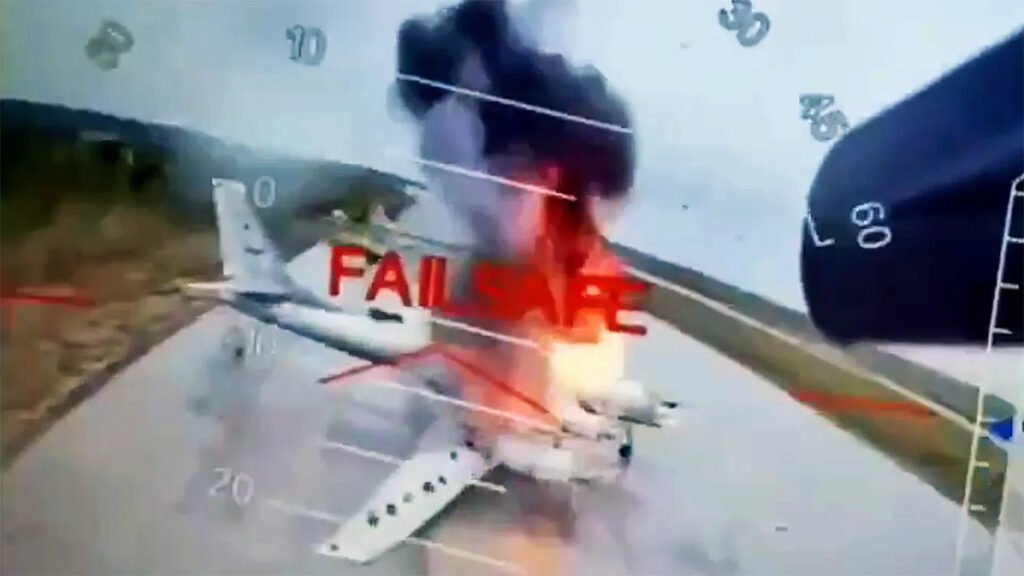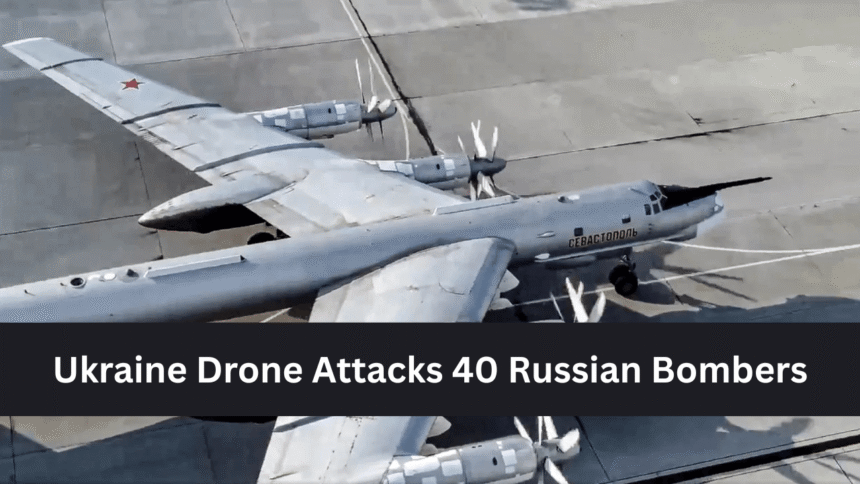In a bold show of defiance and capability, Ukraine claims it has successfully executed one of its most daring military operations to date—an extensive drone attack on multiple Russian airbases. According to Ukrainian intelligence officials, the operation led to the destruction or significant damage of more than 40 Russian military aircraft, including strategic bombers capable of launching long-range missiles. The Ukrainian Security Service, known as the SBU, described the coordinated attack as a “decisive response” to continued Russian aggression and missile strikes on Ukrainian cities.
This assault, reportedly titled “Operation Spider’s Web,” marks a dramatic shift in Ukraine’s tactical approach. Not only did it target deeply embedded military facilities inside Russia, but it also demonstrated a new level of technical sophistication and covert planning. With global attention fixed on potential peace talks, the timing of the Ukraine drone attack has added complexity to the diplomatic landscape.
Strategic Targets: The Backbone of Russia’s Air Superiority
The Ukrainian operation reportedly struck four major military airfields located hundreds of kilometers inside Russian territory. These bases are home to the Tu-95 and Tu-22M3 bombers—key components of Russia’s long-range strategic bomber fleet. Some of the aircraft targeted are capable of delivering nuclear payloads, making the attack especially significant.
Ukrainian military sources assert that 34% of Russia’s strategic missile carrier fleet was impacted. Satellite images and insider footage shared by Ukrainian channels show plumes of black smoke rising from aircraft hangars, burnt fuselages, and emergency crews responding to fires. While Russia has officially acknowledged the drone incursions, it disputes the scale of the damage, calling the claims “grossly exaggerated.” Independent verification remains ongoing due to the restricted nature of military zones.
Nonetheless, if Ukraine’s numbers are accurate, this could represent one of the most successful single-day attacks on strategic air power in modern military history.
Covert Execution and Drone Deployment

The operation stands out not just for its damage output but also for its ingenuity. Ukrainian operatives reportedly used wooden crates disguised as construction materials to transport over 100 first-person view (FPV) drones into Russian territory. These crates were carried by civilian trucks, whose drivers may not have even been aware of the high-tech payload.
Once positioned near the airbases, the drones were launched remotely using AI-guided targeting systems. Each drone, relatively low-cost and built using commercially available components, was equipped with small explosive charges capable of disabling critical aircraft systems such as avionics and fuel lines. The scale and precision of the strike showcased Ukraine’s ability to use asymmetric warfare to its advantage.
The cost-effectiveness of the attack is another factor drawing attention. Reports suggest that each drone cost less than the price of a flagship smartphone, proving that advanced military results can be achieved without massive expenditure—especially when compared to the billions of dollars’ worth of damage allegedly inflicted.
Russia’s Military and Political Response
The Kremlin was quick to label the attack as a “terrorist operation” and vowed a firm response. Russia’s Ministry of Defense claimed that several of the drones were intercepted before reaching their targets, though it did confirm fires and localized damage at multiple installations. Russian media showed images of emergency crews attempting to contain the fires caused by the Ukraine drone attack.
Following the incident, Russia launched a retaliatory wave of its own drone and missile strikes across Ukrainian cities, reportedly the largest aerial assault since the start of 2023. Civilian casualties and widespread infrastructure damage have been reported in several regions. Ukraine, for its part, stated that air defenses intercepted many of the incoming projectiles and vowed to continue defending its territory by any means necessary.
The escalation comes at a sensitive time, as the two nations were expected to send delegations to Istanbul for preliminary peace talks. The talks, which have been proposed by multiple international mediators, are now overshadowed by the renewed violence. Whether both sides will proceed remains uncertain.
Peace Talks Complicated by Attack’s Timing
The incident could not have come at a more precarious moment. With back-channel diplomacy underway and neutral countries like Turkey preparing to host preliminary negotiations, Ukraine’s aggressive drone campaign may be seen as either a strategic upper hand or a provocative misstep.
Ukrainian President Volodymyr Zelenskyy stated that Ukraine will continue to negotiate, but not from a position of weakness. In his words, “We will talk peace only when it reflects justice, sovereignty, and the security of future generations.” Russian officials have yet to issue a formal statement regarding the talks in the wake of the airbase attacks.
From a geopolitical standpoint, Ukraine’s assertion that “Ukraine Claims Drone Attack Hit 40 Russian Bombers as Talks Set to Begin” sends a clear message—it is willing to pursue diplomacy, but will not wait passively while its territory and civilians are under threat.
Check out qoruv.com architect app.
International Reactions and Future Ramifications
The international community has responded with a mix of concern and admiration. Many Western defense analysts view Ukraine’s operation as a major advancement in the use of low-cost, high-impact drone warfare. The shift from conventional to unmanned aerial strategies could reshape global military doctrines.
Several nations have called for restraint and urged both sides to return to the negotiating table. NATO has reaffirmed its support for Ukraine’s right to self-defense, while also emphasizing the importance of avoiding further escalation that could drag other nations into the conflict.
Meanwhile, defense agencies around the world are studying the operation closely. The ability to deliver such a coordinated blow deep within enemy territory without traditional air support reflects the growing importance of drone warfare in the 21st century.
Visit ScoopUpdates.com for more news and updates.
The Road Ahead
The event now widely referred to as “Ukraine Claims Drone Attack Hit 40 Russian Bombers as Talks Set to Begin” is more than a tactical victory; it’s a statement. It demonstrates that Ukraine not only has the will to fight but also the technical know-how to innovate and challenge a larger adversary. As the conflict continues and peace talks remain uncertain, this drone attack may serve as a pivotal moment in shaping the future course of the war.
Whether it leads to deeper conflict or becomes a wake-up call for diplomacy remains to be seen. What is certain is that Ukraine’s strategic messaging—through both technology and timing—has captivated global attention and introduced a new chapter in modern warfare.
Also, read:

